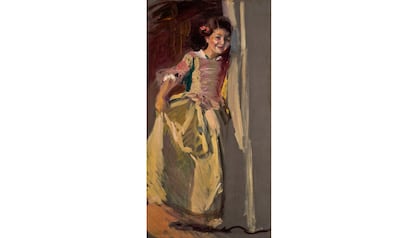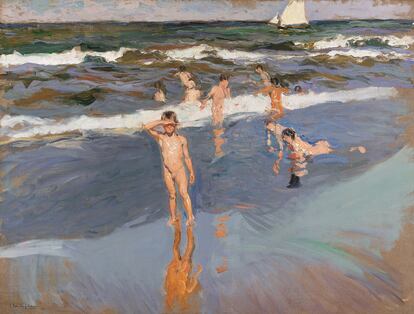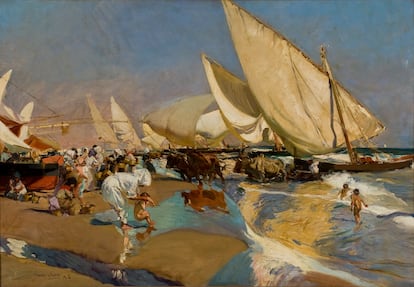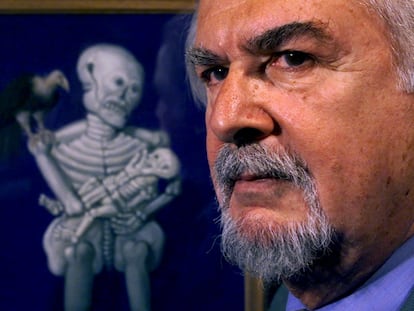Sorolla and the United States, an enduring love affair
The Meadows Museum, which holds one of the country’s most important collections of Spanish art, is commemorating the centennial of the painter’s death with an exhibition of his works from private American collections


These days, two love stories are converging in Dallas. We’re talking about Algur H. Meadows’ love of art, especially the Spanish masters, and Joaquín Sorolla’s romance with the United States. The latter relationship began in 1908 when the millionaire Archer Huntington saw the Spanish painter’s work at the Grafton Gallery in London; 115 years later, the love affair is now celebrating another milestone: the exhibition ‘Spanish Light: Sorolla in American Collections’ at the Meadows Museum. “Today I have decided something that I believe is of great importance for our artistic future in New York, [which has] admirable advantages, not even Paris can compare. I think I have found God made man,” the artist wrote about Huntington to his wife on May 15, 1908, from London.
Examples of the painter’s various loves arrived in Dallas, Texas, for the occasion: his family, his light, his sea, his garden, his country. The exhibition includes the holdings of his American collectors, both current ones and those who bought his work during his lifetime. For the show, around 20 collectors have loaned their Sorollas and 27 of the artist’s approximately 60 works from private collections in the United States are on display. Sorolla is one of the best represented Spanish painters in the country, both in individual collections and at institutions. The exhibit offers the opportunity to enjoy pieces that would otherwise be almost impossible to see.
‘Spanish Light: Sorolla in American Collections’ opened on Sunday, September 17, and it will remain open until January 7, 2024. The exhibition begins with a canvas that has never been exhibited before: a female nude with her back to the viewer from 1886, the artist’s early period. In that first room, there is another nude, also portrayed from behind in another example of Sorolla’s loves: his love for the entire Spanish pictorial tradition, revealing the influence of Diego Velázquez, since the oil painting is inspired by his Venus at her Mirror; and his love for his wife, Clotilde García del Castillo, who is depicted looking at her wedding ring. His great love for her can be seen in their correspondence. He called her his “finance minister,” attesting to her fundamental role in both his personal and professional life.

The fact that this painting appears in the exhibit also represents a token of affection from the Sorolla family—which owns the painting—for the Meadows Museum and, especially, for Mark Roglán, the director of the institution for 15 years until his death in 2021; Roglán is still very much a presence for those who have a relationship with the museum. ‘Spanish Light: Sorolla in American Collections’ is dedicated to him, as he was the one who initiated the project along with Blanca Pons-Sorolla, the exhibit’s curator, as well as the painter’s great-granddaughter and an expert in Sorolla’s legacy. The canvas arrived in Dallas on loan in 2019 for a small exhibition entitled ‘Sorolla in the Studio.’ And then came the pandemic and Roglán’s illness. Since it was already there, the painting remained at the Meadows Museum for the current exhibition, where it is an exception, since it is from a private collection, but not an American one.
Sorolla’s love for his family and for Velázquez are again captured in Elenita Dressed as a Menina (1902), which depicts the painter’s youngest daughter. Another of the paintings that has not been exhibited before, it belonged to Elenita’s descendants until 2020, when it was acquired by an American collector, who owns other works by the artist as well. Tributes to Velázquez are a constant in Sorolla’s works, as is dressing children in the style of Velazquez. He did it with his other daughter, with his friends’ children, and with his grandson Quiquet.
Sorolla was not, and is not, Velázquez’s only admirer. At the Meadows Museum, which invited this newspaper to take a tour, there are three works by Philip IV’s court painter: a portrait of the young king; another of his second wife, Mariana of Austria; and a sibyl, from Algur H. Meadows’s collection. One could not expect anything else from Meadows, who loved the Prado Museum and visited it repeatedly during his stays in Spain. Who is this collector who treasured paintings by Velázquez, Murillo, Goya, Fortuny, Miró, Tàpies, and sculptures from Gil de Siloé’s workshop...? A museum bears his name—the School of the Arts at Southern Methodist University is also named for Meadows—and, along with the Hispanic Society of New York, it is the only place where the Year of Sorolla is being observed to commemorate the centennial of the Spanish painter’s death.













Algur H. Meadows (1899-1978) was an oil and energy industry magnate in the United States. He led the General American Oil Company and wanted to do business in Spain. He went there in search of crude oil and gas and came across the Prado Museum. During his stays in Madrid, the businessman and his wife Virginia stayed at the Ritz Hotel, a stone’s throw away from the art gallery, with which they fell in love. They didn’t find energy in Spain, but they devoted their own energy (and spent their money) in shaping their own Texan Prado. The collection includes Spain’s great masters and a complete representation of the iconographic motifs of Spanish art. In the U.S., the art collectors from Meadows’s time—the mid-twentieth century—and collectors at the beginning of last century who began to acquire Sorollas belonged to the economic elite and wanted to be like the old continent’s aristocracy with European-style collections. And that’s how it went until about 30 years ago, when criteria and interests changed and they began to look elsewhere, especially Latin America.
When Meadows’s first wife died, he donated the works to SMU. In 1965, the museum opened, featuring one of the most important collections of Spanish art in the United States, and it continues to grow. It is a traditional museum with a traditional collection, a chronological and classical history of art; without 21st-century readings, the museum remains faithful to its creator. It currently has about 1,300 pieces, of which approximately 90% are exhibited. In 1965, Meadows changed its acquisition policy. Until then he had purchased art in Spain, where some dealers deceived him with forgeries; after 1965, he began to frequent the American art market and, advised by William Jordan, the museum’s first director, he continued adding to his collection.

Today, the institution’s goals are to add still lifes to its holdings—Amanda Dotseth, the current director, shows special interest in Van der Hamen (Madrid, 1596-1631)—and to increase the number of female artists beyond the miniaturist Francisca Meléndez, Goya’s contemporary, and the avant-garde María Blanchard, who are already represented at the museum.
For its part, the temporary exhibit shows Sorolla’s love-hate relationship with portraits, totally devoted to those of his family and close friends, in which he captures people as they are. Thus, Sorolla demonstrates he captures reality, in any of its dimensions, on his canvases.
The curator confesses that she did not like the commissioned ones very much, but she explains that this genre garners more fame and money for artists. That is what happened with Sorolla, who received many requests, including many in the United States. In 1909, he even painted a portrait of President William Howard Taft, although that work is not in this exhibition because it is not kept in a private collection. The painter felt at ease in the United States, where he gained both economic stability and strength. He admired the determination of the United States and “[its] equal treatment of women,” Pons-Sorolla explains in the catalog. García del Castillo put it this way in a letter she sent her daughters on March 20, 1911: “We have gone to Saint Louis [Missouri] to see how the exhibition was set up, and to buy that automobile…. And since I am so clever, I drive it [safely]. A hug from [your] mother.”

Sorolla also depicted another head of state, Alfonso XIII. A study for The Regency (1903), in which he paints a young king, has not arrived in Dallas yet. The delay stems from a problem with the export permit, since the work is kept in American owner Cristina Heeren’s house in Biarritz, France. It will arrive in a few weeks and then the rarely seen Sorolla piece will finally be put on display. Other paintings owned by Heeren can also be seen in the exhibition: Shadow of the Alcántara Bridge; Juan Ángel, Zarauz; Beach of Valencia and The White Boat. This is one of the most important collections of Sorollas in the U.S. Many are pieces that the owner’s relatives acquired following the painter’s exhibitions in the United States in 1909 and 1911. Of course, it contains the painter’s characteristic themes: beaches, places of recreation and work, sails, children, families, oxen, boats, lights and shadows, moving water and the sun’s reflection touching it all. The White Boat (1905) is a good compendium of all this, a painting in which one can immerse oneself, as in the sea, and get to know the Spanish master featured in this exhibit.
In Dallas, a little piece of collecting history is shared by the exhibit and the museum. The Meadows Museum seeks to spread knowledge about Spanish art. It also spurs the desire to collect Sorollas, a desire that has historically increased after each important exhibition. That was true of the 1909 and 1911 exhibits in the U.S. when he was still alive and more recently in 2013 and 2014 with the ‘Sorolla and the United States’ exhibit, the precursor of the current one; the 2019 exhibit at the National Gallery in London had the same effect. Who knows if the current exhibit will move the market as well. They say that art is expensive, but Dallas boasts of being a city with a high concentration of billionaires.

Sign up for our weekly newsletter to get more English-language news coverage from EL PAÍS USA Edition
Tu suscripción se está usando en otro dispositivo
¿Quieres añadir otro usuario a tu suscripción?
Si continúas leyendo en este dispositivo, no se podrá leer en el otro.
FlechaTu suscripción se está usando en otro dispositivo y solo puedes acceder a EL PAÍS desde un dispositivo a la vez.
Si quieres compartir tu cuenta, cambia tu suscripción a la modalidad Premium, así podrás añadir otro usuario. Cada uno accederá con su propia cuenta de email, lo que os permitirá personalizar vuestra experiencia en EL PAÍS.
¿Tienes una suscripción de empresa? Accede aquí para contratar más cuentas.
En el caso de no saber quién está usando tu cuenta, te recomendamos cambiar tu contraseña aquí.
Si decides continuar compartiendo tu cuenta, este mensaje se mostrará en tu dispositivo y en el de la otra persona que está usando tu cuenta de forma indefinida, afectando a tu experiencia de lectura. Puedes consultar aquí los términos y condiciones de la suscripción digital.
More information
Archived In
Últimas noticias
Most viewed
- Reinhard Genzel, Nobel laureate in physics: ‘One-minute videos will never give you the truth’
- Oona Chaplin: ‘I told James Cameron that I was living in a treehouse and starting a permaculture project with a friend’
- Pablo Escobar’s hippos: A serious environmental problem, 40 years on
- Why we lost the habit of sleeping in two segments and how that changed our sense of time
- Chevy Chase, the beloved comedian who was a monster off camera: ‘Not everyone hated him, just the people who’ve worked with him’










































